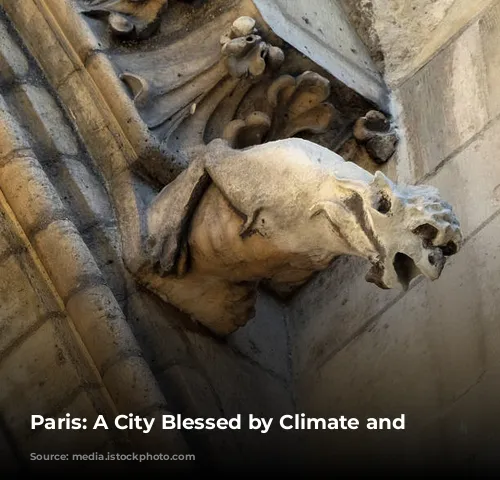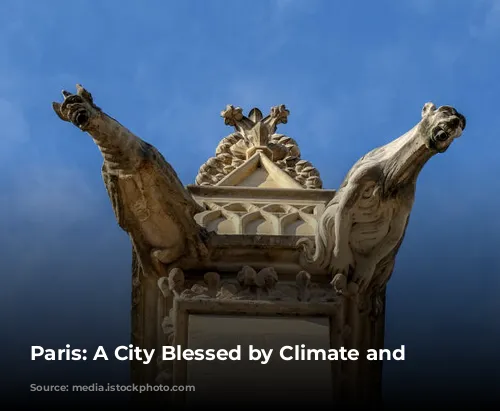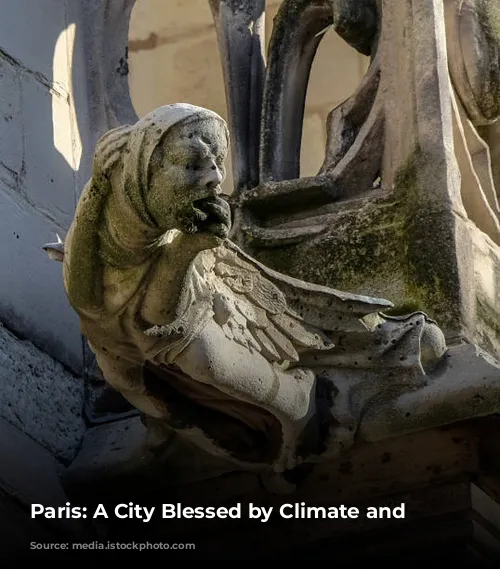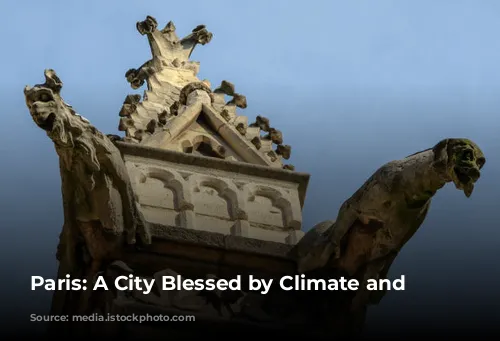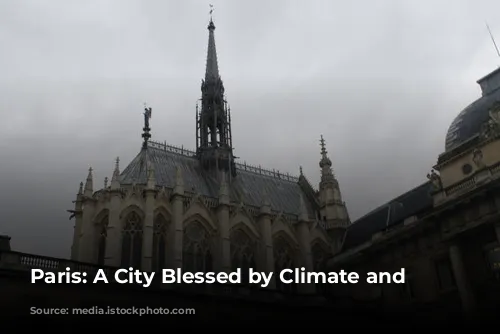Paris, nestled in the western expanse of Europe, enjoys a temperate climate thanks to the Gulf Stream. While generally mild, the weather can be unpredictable during the winter and spring months, bringing sharp winds and chills. The city experiences an average temperature of around 12 degrees Celsius, with the hottest month being July (19°C) and the coldest January (3°C). Freezing temperatures grip Paris for about a month each year, with snow falling on roughly half of those days. However, Paris has actively worked to reduce air pollution and boasts a purified water system making tap water safe for consumption.
Walls of Paris: From Ancient Defenses to Modern Boulevards
Paris’s history is etched in its walls, each layer reflecting a different era. The original Roman settlement on the Left Bank, ravaged by barbarians, saw its blackened stones repurposed to construct a defensive wall on the Île de la Cité. This wall, neglected in times of peace, was rebuilt numerous times over the centuries. The Petit Pont (Little Bridge), the first to connect to the Left Bank, was defended by a fortified gate, the Petit Châtelet. The bridge to the Right Bank, the Pont au Change (Exchange Bridge), was guarded by the Grand Châtelet, which served as a fort, prison, torture chamber, and morgue until its demolition in 1801.
King Philip II (1180-1225) fortified both banks of the Seine with a new wall, further strengthening the city’s defenses. Charles V expanded the Right Bank enclosure in 1367-1370, with the Bastille fortress standing guard at the eastern approaches and the Louvre fortress protecting the west. In 1670, Louis XIV replaced the Charles V walls with the tree-lined Grands Boulevards, adorned with triumphal arches at the Saint-Denis Gate and the Saint-Antoine Gate. The Saint-Denis arch still stands, a testament to the grandeur of the era. The Grands Boulevards, mimicking the river’s arc, extend from the Place de la Madeleine to the Place de la République, forming a vital artery through the city.
In the late 18th century, a new wall was constructed with 57 tollhouses to collect customs duties on goods entering Paris. These tollhouses remain visible at the Place Denfert-Rochereau. The final wall, built in the mid-19th century by Adolphe Thiers for King Louis-Philippe, was a robust military installation with accompanying forts. This wall enclosed several villages outside Paris, including Auteuil, Passy, Montmartre, La Villette, and Belleville, marking the city’s ever-growing presence.
Transformation and Expansion: Paris in the 19th Century
The collapse of Napoleon III’s Second Empire in 1870 and the Industrial Revolution’s influx of employment attracted people to Paris in droves. Railways facilitated this influx, leading to rapid urban growth. Between 1852 and 1870, Baron Haussmann played a pivotal role in transforming Paris, tearing down the farmers-general’s walls and building wide, straight boulevards that sliced through the city’s narrow streets. The 19th-century walls eventually succumbed, and the boulevards were extended in 1925, leaving a lasting mark on the city’s landscape.
The Heart of Paris: Île de la Cité
Île de la Cité, a ship-shaped island nestled in the Seine, is the historical heart of Paris. Eight bridges connect it to the riverbanks, with a ninth bridge leading to the smaller Île Saint-Louis. The westernmost bridge, the Pont Neuf (New Bridge), built between 1578 and 1604, is the oldest of the Paris bridges despite its name. Parisians still refer to something as “solid as the Pont Neuf” due to its remarkable sturdiness. The bridge, supported by the island’s tip, stretches across five arches to the Left Bank and seven to the Right Bank. Its parapet corbels are decorated with over 250 grotesque masks. For two centuries, Pont Neuf was the main street and marketplace of Paris.
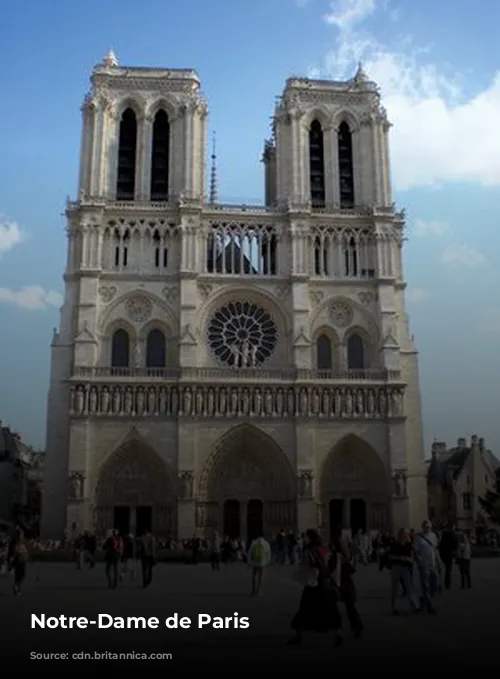
A Legacy of Kings and Justice: Île de la Cité’s Historical Treasures
The tip of Île de la Cité features a triangular gravel-pathed park, surrounded by a cobbled quay popular with sunbathers and lovers. A bronze equestrian statue of King Henry IV, who insisted on the Pont Neuf’s completion, stands where the park meets the bridge. Opposite the statue is the entrance to the Place Dauphine, named for Henry’s heir, the future Louis XIII. This place, once a triangle of red-brick houses, lost its base row in 1871 to make way for the Palace of Justice.
The Palace of Justice, standing on the site of the Roman governor’s palace, was rebuilt by King Louis IX in the 13th century and expanded by Philip IV. The Conciergerie, with its impressive Gothic chambers, was added to the complex. The Great Hall, once the meeting place of the Parlement (high court of justice), was famed for its Gothic beauty. Despite fires in 1618 and 1871, and a devastating fire in 1776, the Great Hall stands as a waiting room for the courts of the Palace of Justice. The Revolutionary Tribunal held court in the first Civil Chamber, condemning approximately 2,600 individuals to the guillotine between 1793 and 1794.
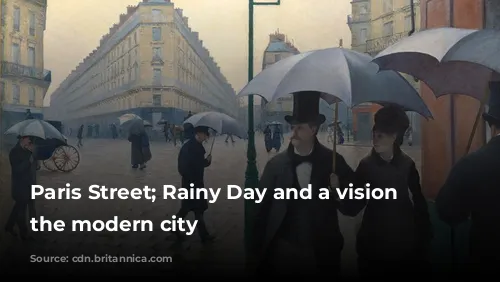
A Legacy of Faith: Sainte-Chapelle and Notre-Dame
In the palace courtyards stands Sainte-Chapelle, a 13th-century masterpiece of the Gothic Rayonnant style. Built under Louis IX between 1243 and 1248, the chapel is a stunning example of architectural daring. The architect, possibly Pierre de Montreuil, designed vaulted ceilings supported by slender columns, with stained glass filling the spaces between. Sainte-Chapelle was built to house the Crown of Thorns, believed to be the one worn by Jesus at his crucifixion. Louis IX purchased the relic from the Venetians, who held it in pawn from the Latin emperor of Constantinople. Other holy relics, including nails and wood from the True Cross, were added to the chapel’s collection, now housed in the treasury of Notre-Dame.

Modernizing the Island: Haussmann’s Transformation
In the 19th century, King Louis-Philippe initiated the “sanitization” of the island, a project continued by Baron Haussmann under Napoleon III. This involved clearing antiquated structures, widening streets and squares, and building new government offices, including sections of the Palace of Justice. The portion of the palace bordering the Quai des Orfèvres became the headquarters of the Police Judiciaire. The Police Prefecture, a 19th-century structure, sits across the boulevard du Palais. On the other side of the prefecture lies the Place du Parvis-Notre-Dame, an open space expanded six times by Haussmann, who also relocated the Hôtel-Dieu, the first hospital in Paris, to the inland side of the square.
Paris, a city where the ancient and the modern intertwine, has long been a source of inspiration and wonder. Its rich history, evident in its walls, bridges, and monuments, continues to captivate visitors from around the globe, making it one of the most beloved cities in the world.
